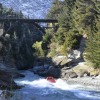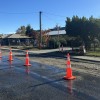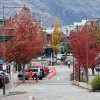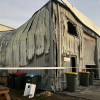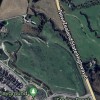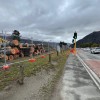
Residents rally against 'up' plans for Arrowtown
Arrowtown is just one of the neighbourhoods potentially set to grow 'up' as the Queenstown Lakes District Council reviews its district plan in response to a national policy statement, but some local residents are worried about the impact the potential plan change could have on their home.
In recent weeks a scaffold tower has risen above Adamson Drive, providing a stark visual representation of the sort of development the proposed new rules would enable.
Clearly marked on the temporary tower - eight metres, then 12 metres.
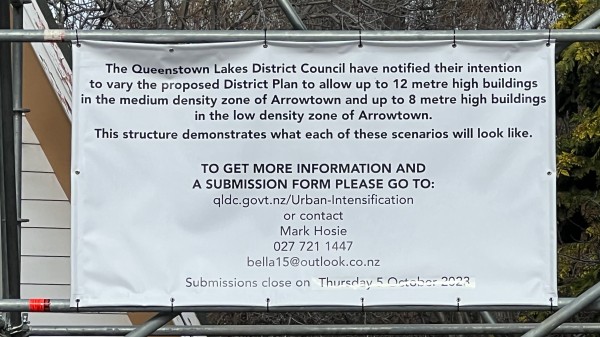
The message on the scaffold tower erected on Arrowtown's Adamson Drive.
Arrowtown resident Mark Hosie, the MC at a public meeting being held tonight at the Arrowtown's Athenaeum Hall, says the two heights are what's proposed for different zones in Arrowtown.
"A lot of people had no concept of what the 12 metres would look like...It's made quite a visual impact."
The Queenstown Lakes District Council has extended the time available for public submissions on its Proposed Urban Intensification Variation.
If implemented, the plan change would affect swathes of Arrowtown, excluding the historic precinct, permitting buildings to increase to 12 metres - that's high enough for a three-storey building - in a block roughly bordered by parts of Kent Street, Suffolk Street, Ford Street, Criterion Street, Norfolk Street, Preston Drive, and Shaw Street, or eight metres in the wider area, all without resource consent.
Arrowtown lawyer Graeme Todd, of Todd and Walker Law, also set to speak at tonight's public meeting, says the district plan variation is the council's response to central government's National Policy Statement for Urban Development 2020, but intended consequences of the proposed plan change are far from guaranteed.
He says the council's assessment of housing stock in the short, medium and long term, which was considered by councillors before moving forwards with the plan change, reveals general availability is not an issue in the district.
"But one area they were concerned about was the provision of different typologies of housing and, in particular, they wanted to provide for intensification and additional height in the hope that might result in housing affordability at less than $500,000."
But it is a gamble that relies on developers jumping onboard willing and able to develop dwellings at that height at that price point.
"There is no guarantee that that outcome will be achieved and there are no rules, or incentives in terms of the rules, contained within the variation, that I can see, which would enhance the possibility of that occurring," Mr Todd says.
"In a community such as ours, it might be easy for developers to take the option and say, 'Well, we'll take the intensification, thank you very much, but we'll provide larger units which will sell for a higher price, because they're going to, especially in the medium density zone, get better views because we're allowed to go to 12 metres'."
Mr Hosie's motivation for getting involved is his fear the "nice, quiet village feel" that attracted him to settle in Arrowtown is at risk by the proposed planning changes.
"All I've seen since I made the decision (to move to Arrowtown) is the QLDC, basically, working hard to erode that amenity value. It's really frustrating to be honest."
He has already fought to retain the town's urban growth boundary and is happy to campaign again, being a voice for the many concerned residents he says have approached him since the variation to the district plan was notified by the council.
It is his view the council did have options to use its discretion in responding to the national policy statement but instead went with a "broad brush approach" and is hiding behind a "government made us to it" stance.
He pushes back at any suggestion of NIMBYism.
"The style of housing that this will enable in Arrowtown is not going to offer anything for the people that really require it...there is absolutely no way that this will provide an affordable housing outcome.
"It will push the property values in Arrowtown up because they can build so high and get so much value out of the land."
The median property value in Arrowtown is already more than $2 million.
Arrowtown is not the only urban area in the Queenstown Lakes District impacted by the proposed planning changes.

Hāwea residents had braced for growth south of Cemetery Road, but a new proposed plan change would 'supercharge it'.
The move has also caused a stir in Hāwea, where it is the latest in a rollercoaster of zoning changes.
The eleventh-hour decision by councillors to include a chunk of newly-zoned residential land in the township in the intensification variation felt "disrespectful", according to Hāwea Community Association spokesperson.
After a lengthy mediation with developers through an Environment Court process the community association had just reached a decision easing the way for a more than doubling of the urban footprint of their lakeside home.
The latest plan change would enable even smaller, denser, and higher developments.
Councillor and Hāwea resident Cody Tucker was at a council-led public meeting a few weeks back, held in Hāwea, to talk residents through the proposed changes.
He says Hāwea residents he has spoken to haven't been supportive of intensified development, primarily because of a fear some of the hard-fought wins they'd just achieved through the mediation process relating to land south of Cemetery Road would be at risk.
There is a community vision for public spaces - a market square, greenways, sports fields, and commercial premises - to offset the impact of proposed housing in the new urban zone.
"The concern is that this super charges the housing aspect without any further consideration of the other components previously mentioned and before any soil's been turned on this land."
However Mr Tucker acknowledges that in the midst of a housing crisis the council has a responsibility to be "an enabler" by allowing for different typologies of housing to ensure it is "not dictating a one-size-fits-all approach" to zoning.
But there is a catch: "I'm always nervous about relying too heavily on the developer to do the right thing as we often have too little to hold them account to."
He says Hāwea has been lucky with local subdivision developer Universal Developments, who, in his opinion, has worked to build a "good social licence" through contributions to the Queenstown Community Housing Trust, a high standard of finish and "one of the best playgrounds in the Upper Clutha" soon to be finished.
But the community has "a bit of PTSD (Post-traumatic stress disorder)" with trust in general when it comes to local developers, as they've watched community infrastructure "historically be the last thing delivered, if ever".
"So without proof that Lake Hāwea has the capability to become a thriving urban centre, it seems a hard ask to zone it as such."
He worries the end result of more intensive zoning may be "shady homes with windows staring at fences" unless there is consideration for the overall cohesiveness of design at this density.
Read more: Higher, denser, smaller: QLDC to consider urban intensification
Be part of the discussion tonight (Tuesday, September 26, 7pm) at the Athenaeum Hall meeting in Arrowtown.
Submissions on the proposed district plan variation close on Thursday, October 5, and the council has its own resources on what it all means and how to have a say available here.















